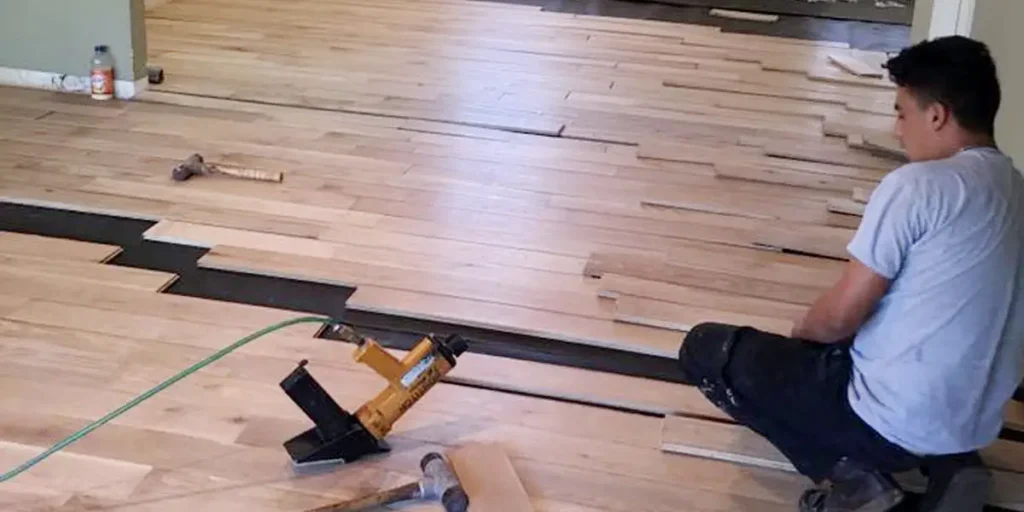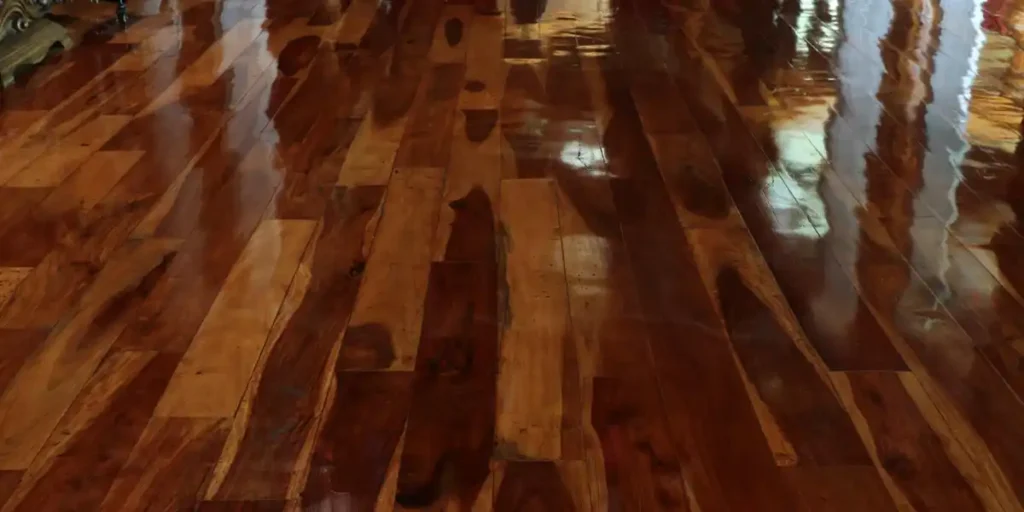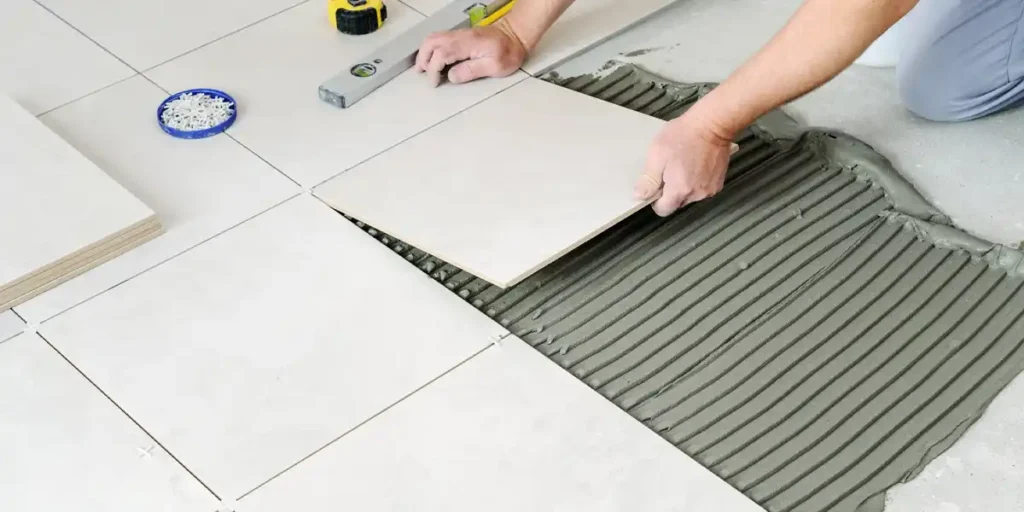Laminate flooring changes how your home looks and feels. It’s durable, versatile, and works in almost any room. If you’ve recently installed laminate flooring, you might be wondering how soon you can walk on laminate flooring after installation.
Imagine you just installed your new laminate floor. You’re eager to walk on it and see how it feels underfoot. But if the floor isn’t ready, stepping on it too soon can undo all the hard work. Planks might shift, adhesives might not set, or gaps might appear. By understanding the right timing and following expert advice, you can avoid these issues and keep your floor in great condition.
This guide covers everything you need to know. It explains how laminate flooring is installed, what factors affect walking times, and what happens if you rush the process.
Understanding Laminate Flooring Installation
Each method of laminate flooring installation comes with its own timeline and preparation steps, and knowing these details helps you get the best results. Rushing can lead to issues, but understanding the process helps you avoid them.
Types of Installation Methods
Laminate flooring can be installed in three main ways:
- Floating Floors: These planks rest on an underlayment and aren’t attached to the subfloor. Because there’s no adhesive involved, floating floors are usually ready to walk on as soon as the installation is done.
- Glued Laminate: This method uses adhesive to secure each plank to the subfloor. While it provides a strong bond, the glue needs time to dry. You’ll need to wait 24-48 hours before walking on these floors.
- Click-and-Lock Laminate: This popular method snaps planks together like puzzle pieces. It doesn’t require glue and is typically ready for use immediately after installation.
Why Timing Matters After Installation
Waiting after installation might feel frustrating, but it makes a big difference. Walking on laminate flooring too soon can cause:
- Plank Shifting: When the floor hasn’t settled, walking can move the planks out of place, creating uneven surfaces.
- Weak Adhesive Bonds: For glued laminate, premature use can prevent the adhesive from setting properly, leading to loose planks over time.
- Visible Damage: Gaps, cracks, and other issues can appear if the floor is used too soon.
Taking the time to let your floor settle and dry ensures a longer lifespan and avoids costly repairs. While it might be tempting to start using your new floor right away, a little patience goes a long way in maintaining its quality.
Factors That Affect Walking Time
How soon you can walk on laminate flooring after installation depends on several factors. Understanding these helps you plan better and avoid unnecessary delays
Environmental Conditions
The room’s temperature and humidity levels directly impact how quickly the floor settles or adhesive dries. For example:
- High Humidity: Moisture in the air slows down the drying process for adhesives and can cause planks to expand or warp.
- Extreme Temperatures: Cold temperatures can delay adhesive curing, while excessive heat may cause planks to shift or contract.
Good ventilation speeds up the drying process and ensures the flooring settles correctly. Keeping the room’s conditions stable during and after installation is essential for avoiding problems. If you’re in a humid or temperature-unstable area, this might extend how soon you can walk on laminate flooring after installation.
Subfloor Preparation and Its Impact
A properly prepared subfloor is the foundation of a successful laminate installation. If the subfloor isn’t level, clean, or dry, it can delay the entire process. For instance:
- Uneven Surfaces: An uneven subfloor may require leveling before installation, which adds time.
- Moisture Problems: A damp subfloor can interfere with adhesive bonds and may lead to long-term issues like warping.
Professional installers often check and prepare the subfloor beforehand to ensure the laminate flooring performs as expected. Neglecting this step can lead to delays and potential damage down the line.
Type of Adhesive or Underlayment Used
The adhesive or underlayment plays a big role in how quickly your floor is ready for use:
- Fast-Drying Adhesives: These adhesives can set in as little as 12 hours, allowing for quicker use of glued laminate flooring.
- Standard Adhesives: These require a longer drying time, typically 24-48 hours.
- Floating Floors with Underlayment: Since floating floors don’t use adhesive, you can walk on them immediately after installation.
Knowing the type of adhesive or underlayment used helps you estimate when it’s safe to start walking on your new floor.
Recommended Waiting Times for Different Methods
Each installation method comes with its own recommended waiting time. Sticking to these timelines ensures your floor remains durable and functional.
Floating Floors
Floating floors are among the quickest options to become usable. Since they rest on an underlayment and aren’t glued down, there’s no drying time involved. As soon as the final plank is clicked into place, you can walk on the surface. This makes floating floors a popular choice for families who need quick and hassle-free installation. Even so, consider light foot traffic initially to let the planks fully settle.
Glued Laminate
Glued laminate flooring requires more patience but delivers a strong and durable bond. Adhesives used for this method typically take 24-48 hours to dry and cure properly. Walking on the floor before this time can disrupt the adhesive, leading to loose or misaligned planks. If possible, wait the full 48 hours to ensure optimal durability and stability. Ask your installer about the specific adhesive used to confirm the drying time and avoid any premature use.
Click-and-Lock Laminate
Click-and-lock laminate is the most convenient in terms of usability. Since it doesn’t rely on adhesive, the floor is ready for use immediately after installation. However, allowing a few hours for the floor to settle can make a difference in long-term performance. Light usage during the first day is fine, but avoid dragging heavy furniture or engaging in high-impact activities right away to maintain the floor’s integrity.
Consequences of Walking Too Soon
Walking on your laminate flooring too soon can lead to several issues. Let’s explore what can go wrong and why patience pays off.
Misaligned Planks
Stepping on the floor too early can shift planks out of place. This creates uneven surfaces and gaps that are difficult to fix later. Misaligned planks not only affect the appearance but also weaken the floor’s overall structure. Ensuring proper curing or settling time helps maintain the floor’s seamless look.
Weakening Adhesive Bonds in Glued Laminate
In glued installations, premature use can interrupt the drying process. This weakens the adhesive bonds and increases the chances of planks loosening over time. Strong adhesive bonds are critical for keeping the floor stable and intact. Waiting even a few extra hours can prevent long-term issues.
Increased Risk of Cracks and Gaps in the Floor
Putting pressure on unset planks can cause cracks or gaps to form, especially if the adhesive hasn’t dried or the planks haven’t settled. These issues reduce the floor’s lifespan and may require costly repairs. Avoiding early foot traffic ensures these problems don’t occur.
Long-Term Costs of Early Wear and Tear
Damaged flooring often requires expensive fixes. Whether it’s repairing misaligned planks or replacing sections that have cracked, the costs can add up quickly. Following the recommended waiting time saves money and keeps your floor in great shape for years to come.
Preparing Heavy Furniture for Placement After Installation
Moving heavy furniture onto newly installed laminate flooring requires extra care. Placing furniture too soon or doing it incorrectly can lead to damage that undermines all the work put into your floor.
Why Heavy Furniture Requires Special Attention
Heavy furniture exerts pressure on your flooring. If the adhesive hasn’t fully dried or the planks haven’t settled, this weight can disrupt the installation. Even for floating and click-and-lock floors, improper placement can cause scratches, dents, or plank misalignment.
Tips for Safe Placement
- Wait for the Recommended Time: Always follow the drying or settling guidelines based on your flooring type. For glued laminate, wait at least 48 hours before placing furniture.
- Use Furniture Pads or Sliders: These reduce the pressure on your floors and make moving furniture easier. Felt pads work well for permanent placement, while sliders are ideal for adjustments.
- Distribute Weight Evenly: Avoid concentrating heavy furniture in one spot, as this can create dips or weaken the floor over time.
- Lift Instead of Dragging: Dragging furniture across the floor can cause deep scratches or damage the floor’s protective layer. Always lift items when moving them.
- Plan Your Layout: Before moving furniture back into the room, map out where everything will go. This minimizes the need for adjustments after placement, reducing the risk of damage.
Comparing Different Installation Methods and Their Timelines
Different installation methods require different waiting times. Comparing them helps you choose what works best for your schedule and needs.
Floating Floors vs. Glued Laminate
Floating floors are ready right away, while glued laminate takes 24-48 hours to set. If you need a quick turnaround, floating floors are the better option. However, glued laminate provides a more permanent solution in some cases.
Why Click-and-Lock Laminate Is Ready Faster
Click-and-lock laminate doesn’t require glue, so it is usable almost immediately. This method is great for fast installations without compromising on quality. How soon you can walk on laminate flooring after installation using this method is nearly instantaneous, making it a convenient choice for busy households.
Installation Techniques That Reduce Waiting Times
Using fast-drying adhesives or choosing floating floors can cut down on waiting time. Hiring professional installers ensures the job is done efficiently and meets safety standards. These techniques help you get back to using your space sooner.
Preparing Your Laminate Floor for Safe Use
Taking care of your new floor right after installation helps it last longer and perform better.
How to Protect Freshly Installed Floors
- Use rugs or mats in high-traffic areas to reduce wear.
- Avoid placing heavy furniture immediately after installation.
- Keep the floor clean to prevent scratches and debris buildup.
Common Mistakes to Avoid After Installation
- Walking on the floor before it is ready.
- Dragging furniture across the floor without protection.
- Ignoring signs of damage, like loose planks or gaps.
Temporary Measures for High-Traffic Areas
If you need to use the room quickly:
- Place protective coverings like cardboard or plywood over the floor.
- Limit foot traffic to essential areas only.
- Monitor the floor for any signs of shifting or damage.
Special Considerations for Laminate Flooring in High-Humidity Areas
Laminate flooring performs well in most environments, but high humidity presents unique challenges. Understanding these can help you maintain your floors effectively in damp conditions.
Challenges of Humidity on Laminate Floors
- Warping and Buckling: Excess moisture causes laminate planks to expand. Over time, this can lead to warping or buckling, especially if the subfloor isn’t properly sealed.
- Slower Adhesive Drying: In glued installations, high humidity delays the curing process, which can extend how soon you can walk on laminate flooring after installation.
- Mold Growth: Prolonged exposure to moisture increases the risk of mold beneath the planks, which can compromise both the floor and your health.
Preventing Humidity-Related Issues
- Use a Dehumidifier: Maintain indoor humidity levels between 30% and 50% to protect your floors.
- Acclimate Planks Before Installation: Let the laminate planks sit in the room for 48-72 hours before installation. This allows them to adjust to the environment, reducing the risk of warping.
- Seal the Subfloor: A properly sealed subfloor prevents moisture from seeping into the laminate. This is particularly important in basements or other damp areas.
- Choose Water-Resistant Laminate: Some laminate flooring options are specifically designed for high-humidity areas. These provide an extra layer of protection against moisture.
- Monitor Ventilation: Ensure proper airflow in the room. Exhaust fans or open windows can help regulate humidity levels.
How Soon You Can Walk on Newly Installed Laminate Floors?
How soon you can walk on laminate flooring after installation depends on the method and conditions. Floating and click-and-lock floors are ready almost immediately, but glued laminate requires patience. Following the recommended waiting times prevents damage and ensures your floors remain durable.
Taking precautions, understanding the installation method, and preparing your floor for safe use all contribute to its longevity. By following these guidelines, you can enjoy your laminate flooring for years to come without unexpected issues.
Get in touch with Cardenas Flooring now for highly professional Laminate flooring.
FAQs
Can I Use Rugs Immediately After Installation?
Yes, but only for floating and click-and-lock floors. For glued laminate, wait until the adhesive fully cures. This precaution ensures the floor settles properly.
What Should I Do If I Walked on the Floor Too Soon?
Check for visible damage like shifted planks or gaps. If you notice issues, consult a professional installer for repairs. Acting quickly can prevent further complications.
How Can I Speed Up the Drying Process for Glued Laminate?
Ensure proper ventilation and maintain a stable temperature in the room. Fans can help circulate air and speed up drying. While you cannot rush the process entirely, these steps help.




